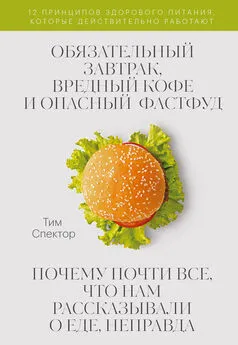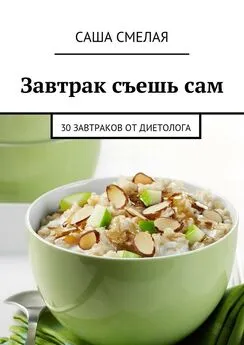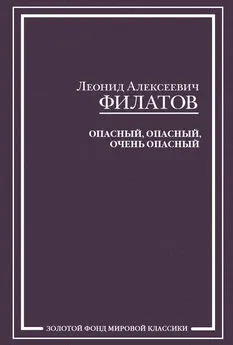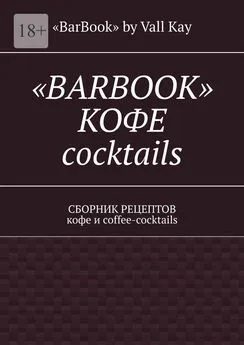Тим Спектор - Обязательный завтрак, вредный кофе и опасный фастфуд
- Название:Обязательный завтрак, вредный кофе и опасный фастфуд
- Автор:
- Жанр:
- Издательство:Манн, Иванов и Фербер
- Год:2021
- Город:Москва
- ISBN:9785001697381
- Рейтинг:
- Избранное:Добавить в избранное
-
Отзывы:
-
Ваша оценка:
Тим Спектор - Обязательный завтрак, вредный кофе и опасный фастфуд краткое содержание
Тим Спектор провел беспрецедентное исследование, в результате которого понял, насколько необоснованны большинство глубоко укорененных в нашем сознании представлений о еде. В каждой главе своей книги он объясняет, почему почти всё, что нам рассказывали о еде, неправда.
Прочитав его книгу, вы сможете полностью переосмыслить свое отношение к еде и научитесь формировать собственный индивидуальный рацион на основе научных рекомендаций.
Обязательный завтрак, вредный кофе и опасный фастфуд - читать онлайн бесплатно ознакомительный отрывок
Интервал:
Закладка:
225
Flaten M. A. Expectations and placebo responses to caffeine-associated stimuli // Psychopharmacology. 2003. Vol. 169. No. 2. Pp. 198–204; Benke C. Effects of anxiety sensitivity and expectations on the startle eyeblink response during caffeine challenge // Psychopharmacology. 2015. Vol. 232. No. 18. Pp. 3403–3416.
226
Mills L. Placebo caffeine reduces withdrawal in abstinent coffee drinkers // Psychopharmacology. 2016. Vol. 30. No. 4. Pp. 388–394.
227
EFSA. EFSA opinion on the safety of caffeine. 23 June 2015.
228
Teucher B. Dietary patterns and heritability of food choice in a UK female twin cohort // Twin Research and Human Genetics. 2007. Vol. 10. No. 5. Pp. 734–748.
229
Dulloo A. G. Normal caffeine consumption: influence on thermogenesis and daily energy expenditure in lean and postobese human volunteers // American Journal of Clinical Nutrition. 1989. Vol. 49. No. 1. Pp. 44–50.
230
Doherty M. Effects of caffeine ingestion on rating of perceived exertion during and after exercise: a meta-analysis // Medicine and Science in Sports. 2005. Vol. 15. No. 2. Pp. 69–78.
231
nhs.uk/conditions/pregnancy-and-baby/foods-to-avoid-pregnant/(23 January 2017); acog.org/Patients/FAQs/Nutrition-During-Pregnancy?(February 2018).
232
Rhee J. Maternal caffeine consumption during pregnancy and risk of low birth weight: A Dose-response meta-analysis // PLOS ONE. 2015. Vol. 10. No. 7. P. e0132334.
233
Holst L. Raspberry leaf — should it be recommended to pregnant women? // Complementary Therapies in Clinical Practice. 2009. Vol. 15. No. 4. Pp. 204–208.
234
Kennedy D. A. Safety classification of herbal medicines used in pregnancy in a multinational study // BMC Complementary Alternative Medicine. 2016. Vol. 16. No. 102.
235
Riley E. P. Fetal alcohol spectrum disorders: an overview // Neuropsychology Review. 2013. Vol. 21. No. 2. Pp. 73–80.
236
Kesmodel U. S. The effect of different alcohol drinking patterns in early to mid pregnancy on the child’s intelligence, attention, and executive function // BJOG. 2012. Vol. 119. No. 10. Pp. 1180–1190.
237
Popova S. Estimation of national, regional, and global prevalence of alcohol use during pregnancy and fetal alcohol syndrome: a systematic review and meta-analysis // The Lancet. 2017. Vol. 5. Pp. e290–e299.
238
Goldstein R. F. Association of gestational weight gain with maternal and infant outcomes: a systematic review and meta-analysis // JAMA. 2017. Vol. 317. No. 21. Pp. 2207–2225.
239
По российским рекомендациям дополнительная потребность в энергии у беременных составляет 350 ккал в день во второй половине беременности. Прим. науч. ред.
240
nice.org.uk/guidance/ph27/chapter/1-Recommendations#recommendation-2-pregnant-women(July 2010).
241
Tam C. H. The impact of maternal gestational weight gain on cardiometabolic risk factors in children // Diabetologia. 2018. Vol. 61. No. 12. Pp. 2539–2548.
242
Allen-Walker V. Routine weighing of women during pregnancy — is it time to change current practice? // BJOG. 2015. Vol. 123. No. 6. Pp. 871–874.
243
Hytten F. Is it important or even useful to measure weight gain in pregnancy? // Midwifery. 1990. Vol. 6. No. 1. Pp. 28–32; Dawes M. G. Repeated measurement of maternal weight during pregnancy. Is this a useful practice? // BJOG. 1991. Vol. 98. No. 2. Pp. 189–194.
244
nhs.uk/common-health-questions/pregnancy/how-much-weight-will-i-put-on-during-my-pregnancy/(18 October 2018).
245
Dalrymple K. V. Lifestyle interventions in overweight and obese pregnant or postpartum women for weight management: a systematic review // Nutrients. 2018. Vol. 10. No. 11. P. e1704.
246
Alvarado-Esquivel C. Miscarriage history and Toxoplasma gondii infection: a cross-sectional study in women in Durango City, Mexico // European Journal of Microbiology and Immunology. 2014. Vol. 4. No. 2. Pp. 117–122; Roberts F. Histopathological features of ocular toxoplasmosis in the fetus and infant // Archives of Ophthalmology. 2001. Vol. 119. No. 1. Pp. 51–58.
247
nhs.uk/conditions/pregnancy-and-baby/foods-to-avoid-pregnant/(23 January 2017).
248
Действительно, в России нет рекомендаций об исключении копченых продуктов из рациона беременных. Прим. науч. ред.
249
Villazanakretzer D. L. Fish parasites: a growing concern during pregnancy // Obstetrical & Gynecological Survey. 2016. Vol. 71. No. 4. Pp. 253–259.
250
Taylor C. M. A review of guidance on fish consumption in pregnancy: is it fit for purpose? // Public Health Nutrition. 2018. Vol. 21. No. 11. Pp. 2149–2159.
251
Solan T. D. Mercury exposure in pregnancy: a review // Journal of Perinatal Medicine. 2014. Vol. 42. No. 6. Pp. 725–729.
252
Ebel E. Estimating the annual fraction of eggs contaminated with Salmonella enteritidis in the United States // International Journal of Food Microbiology. 2000. Vol. 61. No. 1. Pp. 51–62.
253
Gyang A. Salmonella Mississippi: a rare cause of second trimester miscarriage // Archives of Gynecology and Obstetrics. 2008. Vol. 277. No. 5. Pp. 437–438; Ravneet K. A case of Salmonella typhi infection leading to miscarriage // Journal of Laboratory Physicians. 2011. Vol. 3. No. 1. Pp. 61–62; Majowicz S. E. The global burden of nontyphoidal salmonella gastroenteritis // Clinical Infectious Diseases. 2010. Vol. 50. No. 6. Pp. 882–889.
254
bbc.co.uk/news/magazine-32033409(25 March 2015).
255
Awofisayo A. Pregnancy-associated listeriosis in England and Wales // Epidemiology and Infection. 2015. Vol. 143. No. 2. Pp. 249–256.
256
Знак «Красный лев» ставится на яйцах, которые производятся по особому стандарту, позволяющему максимально снизить риск заражения сальмонеллезом, эти яйца разрешено есть сырыми даже уязвимым категориям граждан (к которым относятся дети и беременные). В частности, стандарт подразумевает обязательную вакцинацию кур от сальмонеллеза. Прим. науч. ред.
257
Madjunkov M. Listeriosis during pregnancy // Archives of Gynecology and Obstetrics. 2017. Vol. 296. No. 2. Pp. 143–152.
258
cdc.gov/listeria/technical.html(12 December 2016).
259
Fox M. Prepared salads recalled for salmonella, listeria risk // NBC News. 19 October 2018.
260
Withers M. Traditional beliefs and practices in pregnancy, childbirth and postpartum: a review of the evidence from Asian countries // Midwifery. 2018. Vol. 56. Pp. 158–170.
261
Nagata C. Hot — cold foods in diet and all-cause mortality in a Japanese community: the Takayama study // Annals of Epidemiology. 2017. Vol. 27. No. 3. Pp. 194–199.
262
Koren O. Host remodeling of the gut microbiome and metabolic changes during pregnancy // Cell. 2012. Vol. 150. No. 3. Pp. 470–480; Thornburn A. N. Evidence that asthma is a developmental origin disease influenced by maternal diet and bacterial metabolites // Nature Communications. 2015. Vol. 6. P. 7320.
263
cdc.gov/healthcommunication/toolstemplates/entertainmented/tips/Allergies.html(12 August 2019).
264
Gupta R. S. Prevalence and severity of food allergies among US adults // JAMA Netw. Open. 2019. Vol. 2. No. 1. P. e185630.
265
Love S. Food intolerance tests are shoddy science and traps for disordered eating // Vice. 23 February 2018.
266
Wenyin L. The epidemiology of food allergy in the global context // International Journal of Environmental Research and Public Health. 2018. Vol. 15. No. 9. P. 2043.
267
Hammond C. Unproven diagnostic tests for food allergy // Immunology and Allergy Clinics of North America. 2018. Vol. 31. No. 1. Pp. 153–163.
268
Venkataram D. Prevalence and longitudinal trends of food allergy during childhood and adolescence: results of the Isle of Wight Birth Cohort study // Clinical and Experimental Allergy. 2018. Vol. 48. No. 4. Pp. 394–402.
269
Yousef E. Clinical utility of serum specific IgE food testing in general practice: a tertiary care experience // Journal of Allergy and Clinical Immunology. 2019. Vol. 143. No. 2. P. AB275.
270
Описанный метод — это аллерген-специфическая иммунотерапия (АСИТ-терапия). Основы этой методики разработаны в 1911 году врачами Леонардом Нуном и Джоном Фриманом. Прим. науч. ред.
271
Vickery B. P. AR101 oral immunotherapy for peanut allergy // New England Journal of Medicine. 2018. Vol. 379. No. 21. Pp. 1991–2001.
272
Pretorius R. A. Maternal fiber dietary intakes during pregnancy and infant allergic disease // Nutrients. 2019. Vol. 11. No. 8. P. 1767.
273
Eigenmann P. A. Are avoidance diets still warranted in children with atopic dermatitis? // Pediatric Allergy and Immunology. 2020. Vol. 1. Pp. 19–26.
274
Овес содержит белок из группы проламинов авенин, его структура отличается от структуры глютена пшеницы. Для большинства больных целиакией употребление овса не опасно. Прим. науч. ред.
275
Lebwohl B. Long term gluten consumption in adults without celiac disease and risk of coronary heart disease: prospective cohort study // BMJ. 2017. Vol. 357. P. j1892.
276
Volta U. High prevalence of celiac disease in Italian general population // Digestive Diseases and Science. 2011. Vol. 46. No. 7. Pp. 1500–1505.
277
Biesiekierski J. R. Non-coeliac gluten sensitivity: piecing the puzzle together // United European Gastroenterology. 2015. Vol. 3. No. 2. Pp. 160–165.
278
Melini V. Gluten-free diet: gaps and needs for a healthier diet // Nutrients. 2019. Vol. 11. No. 1. P. 170.
Читать дальшеИнтервал:
Закладка:










